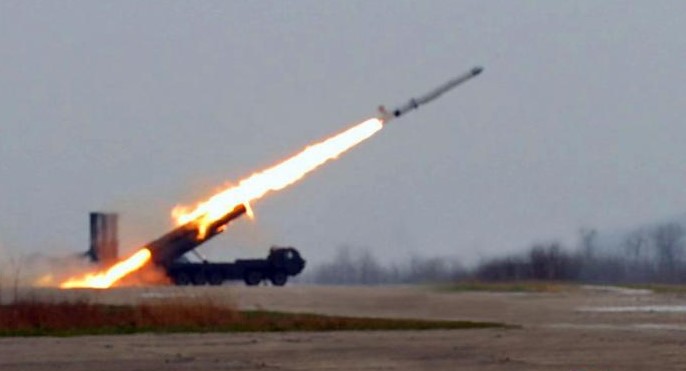North Korea and Iran are deepening their collaboration, sharing expertise and technology, notably in ballistic missiles, heightening the global threat amid instability heightened by missile exchanges in the Israel-Iran conflict.
Several experts note that the recent barrage of missiles launched by Tehran resembles North Korea’s Rodong missiles. Furthermore, Pyongyang’s dispatch of a high-level delegation to Tehran suggests a heightened level of collaboration between the two nations.
After Iran launched over 300 drones and missiles toward Israel on April 13, certain experts speculated about the potential use of North Korean parts or military technology.
“The ballistic missile Iran fired on April 13 against Israel is similar to North Korea’s Rodong missile. The debris of the launched missile was recovered from the Mediterranean Sea near Israel. The recovered propulsion system was identified as the ‘Emad’ missile,” said Lee Il-woo, director at Korea Defence Network.
The Emad missile is an Iranian-designed, liquid-fueled medium-range ballistic missile (MRBM) derived from the Shahab-3 missile.
“While the Rodong missile technology served as the initial foundation of the Emad, collaborative efforts led to performance improvements. The Rodong missile had a range of about 1,000 kilometers, but missiles like the Emad increased this to 1,700 kilometers, along with an increase in payload capacity.”
North Korea announced on Wednesday that it had dispatched a high-level delegation to Iran, fueling further speculation about potential military collaboration between the two nations.
The North’s Korean Central News Agency reported that the delegation departed from Pyongyang on Tuesday. The purpose of the visit, according to the report, is to engage in external economic activities.
The timing of the delegation’s visit is significant, particularly in light of North Korea’s vocal support for Russia, currently embroiled in conflict with Ukraine. Experts speculate that this could signal a shift in dynamics, with North Korea and Iran potentially deepening military ties, particularly in light of their shared stance on the Russia-Ukrain war.
The U.S. Defense Intelligence Agency (DIA) has been vocal about the significant impact of North Korean expertise on Iran’s military capabilities. The integration of North Korean technology into Iran’s weapons systems, especially in the development of medium-range ballistic missiles (MRBMs) such as the Shahab-3 and Khorramshahr missiles, has raised alarms within the defense community. The Shahab-3 is reportedly based on North Korea’s Rodong missile, while the Khorramshahr missile was developed with North Korean assistance.
This partnership between North Korea and Iran is not a recent phenomenon, but has roots tracing back to the 1980s. Despite diplomatic and economic pressure from the international community, both nations, driven by shared anti-U.S. sentiments, have persistently pursued nuclear and missile programs.
“It could be said that North Korea’s missile technology began alongside that of Iran’s. In the past, when North Korea struggled to acquire ballistic missile technology even from China, it received Russian Scud missiles and mobile launchers from Iran. North Korea then reverse-engineered and copied this technology, marking the inception of its ballistic missile development,” Shin Jong-woo, a senior researcher at the Korea Defense and Security Forum said.
“Iran also has largely advanced its missile development in tandem with North Korea, having initially received missile technology from them.”
Iran, alongside Egypt, emerged as one of the early clients for North Korean ballistic missiles in the early 1980s, procuring several hundred Hwasong-5 missiles during the Iran-Iraq War. Over time, this relationship evolved, with Iran acquiring longer-range missiles and exploring domestic license production of North Korean missiles.
Recent assessments by U.S. intelligence agencies indicate a trend of increased ballistic missile cooperation between North Korea and Iran since 2013. Moreover, experts caution that this collaboration extends beyond missiles, encompassing other fields, such as uranium enrichment centrifuge construction and submarine development, as highlighted in reports by the U.N. Security Council Sanctions Committee on North Korea.
Ian Williams, the deputy director of the Missile Defense Project at the Center for Strategic and International Studies (CSIS), emphasized Iran’s advanced capabilities in solid-fuel technology compared to North Korea. This suggests a dangerous potential for further advancements in missile capabilities through continued collaboration between the two nations. The transfer of expertise from Iran, coupled with North Korea’s missile technology, could significantly enhance Tehran’s ballistic missile capabilities, posing a grave threat.
As tensions between Iran and Israel continue to mount, questions arise regarding the potential utilization of North Korean weaponry in regional conflicts with the possibility of Tehran deploying advanced missiles developed through collaboration with Pyongyang.
“The threat has reached its peak, enabling both parties to develop new technologies more affordably for practical deployment. Iran, for instance, conducts tests and distributes such weapons en masse to what are termed ‘axis of resistance’ nations. They also occasionally acquire components from North Korea for resale. In such instances, economies of scale drive down production costs, fostering mutually beneficial relationships,” Lee said. ( Source: Korea Times)


